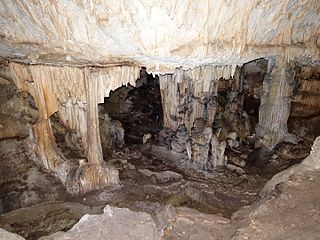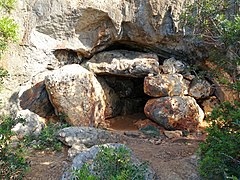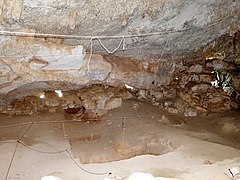Cova des Moro (Manacor)
| Cova des Moro
|
||
|---|---|---|
| Location: | Manacor , Mallorca , Spain | |
|
Geographic location: |
39 ° 30 '16.5 " N , 3 ° 18' 6.2" E | |
|
|
||
| Geology: | limestone | |
| Type: | Dripstone cave , karst cave | |
| Lighting: | No | |
| Overall length: | 60 meters | |
| Level difference: | 16 meters | |
The Cova des Moro ('Moors Cave') is a stalactite cave on the east coast of the Spanish Balearic island of Mallorca . It is one of several karst caves south of the town of S'Estany d'en Mas in the municipality of Manacor , which are collectively referred to as the Coves des Pirata ('pirate caves'), which indicates their location near the sea. The entrance to the Cova des Moro is located a little over halfway up the steep coast near Cala Falcó ('Falcon Bay').
location
The entrance to the Cova des Moro is 140 meters northeast of Cala Falcó within the nature reserve Cales Verges de Manacor . The next town, S'Estany d'en Mas, is 1400 meters to the north, the larger bay of Cala Varques 700 meters to the southwest and the historic fortified tower Son Fortesa 2300 meters to the west.
The cave entrance, framed by megaliths, at a height of 16 meters above sea level, is surrounded by bushes that grow on a small rock platform on the cliff. From there, the 30-meter-wide main rooms of the Cova des Moro extend about 60 meters to the west. The height difference of the cave is a total of 16 meters. Other nearby karst caves are the Cova de Cala Falcó and the Cova des Coloms directly on the coast , inland the Cova des Pirata and the Cova des Pont .
history
The Cova des Moro was, like the other "Pirate Caves" around by karst formation of limestone . Excavations carried out in the cave revealed information about the prehistoric fauna and the settlement of Mallorca. So in the Cova des Moro remains of the 1800 BC were found. Extinct cave goat (Myotragus balearicus) .
A human bone found in the cave is believed to date from 2470 to 2130 BC. Dated. It is considered the oldest find in the Balearic Islands and shows genetic components of nomads who came to the Iberian Peninsula from the steppes of Eastern Europe ( Kurgan culture ) . Another indication of settlement is the jaw of a non-indigenous goat, which came to light during the excavations and dates from 2290 to 2030 BC. Is classified. The animal must have been domesticated or at least introduced to the island. Ceramics found in the cave are assigned to different time periods, such as the Talaiot culture or the Islamic period of the island's history, the time of the Moors , from which the Cova des Moro takes its name. During the Christian conquest of Mallorca from 1229, the cave served the Muslims as a place of refuge.
- Views of the cave
Emerging stalagmites
literature
- Miquel Trias, Francesc Mir: Les Coves de la Zona de Can Frasquet - Cala Varques . In: Endins . No. 4 . Comité Balear d'Espeleologia, Palma de Mallorca 1977, p. 30–33 ( online [PDF; accessed July 7, 2016]).
Individual evidence
- ↑ Cova des Moro (Manacor, Mallorca). www.myotragus.org, May 20, 2016, accessed July 7, 2016 (Catalan).
- ↑ a b Antonio Sureda Milan: Coves des Pirata, des Moro, de Cala Falcó y de Cala Varques A. (No longer available online.) Webs.ono.com, March 19, 2013, archived from the original on August 25, 2016 ; Retrieved July 7, 2016 (Spanish).
- ↑ Miquel Trias, Francesc Mir: Les Coves de la Zona de Can Frasquet - Cala Varques . In: Endins . No. 4 . Comité Balear d'Espeleologia, Palma de Mallorca 1977, p. 30 ( raco.cat [PDF; accessed July 7, 2016]).
- ↑ Miquel Trias, Francesc Mir: Les Coves de la Zona de Can Frasquet - Cala Varques . In: Endins . No. 4 . Comité Balear d'Espeleologia, Palma de Mallorca 1977, p. 33 ( raco.cat [PDF; accessed July 7, 2016]).
- ↑ Francesc Gràcia, Bernat Clamor, Joan J. Fornós, Damià Jaume, Mateu Febrer: El sistema Pirata - Pont - Piqueta (Manacor, Mallorca): Geomorfologia, espeleogènesi, hidrologia, sedimentologia i fauna . In: Endins . No. 29 . Comité Balear d'Espeleologia, Palma de Mallorca 2006, p. 32 (Catalan, imedea.uib-csic.es [PDF; 1.1 MB ; accessed on July 7, 2016]).
- ↑ Pere Bover Arbós, Damià Ramis Bernat: Els jaciments paleontològics de Myotragus del terme municipal de Manacor: la seva aportació al coneixement del gènere. (PDF; 3,993.45 kB) www.manacor.org, June 30, 2014, pp. 77–87 , accessed on July 7, 2016 (Catalan).
- ↑ a b Helen Dawsen: Mediterranean Voyages: The Archeology of Iceland colonization and Abandonment . Left Coast Press, Walnut Creek, California 2014, ISBN 978-1-61132-994-0 , Island Colonization in the Western Mediterranean, pp. 78 ( digitized version [accessed July 7, 2016]).
- ↑ Martin Breuninger: From the vastness of the steppes to the Balearic Islands . In: Mallorca Magazin . No. 14/2020 . Grupo Serra, Palma April 2, 2020, p. 31 .
- ↑ Miquel Trias, Francesc Mir: Les Coves de la Zona de Can Frasquet - Cala Varques . In: Endins . No. 4 . Comité Balear d'Espeleologia, Palma de Mallorca 1977, p. 32 ( online [PDF; accessed July 7, 2016]).
- ↑ Damià Ramis, Gabriel Santandreu: Arqueologia de les Cavernes de les Illes Balears . In: Endins . No. 35 . Federació Balear d'Espeleologia, 2011, ISSN 0211-2515 , p. 325 ( online [PDF; 17.8 MB ; accessed on July 7, 2016]).
- ↑ M. Magdalena Riera woman: Els materials “andalusins” de la Cova des Moro (Manacor). (PDF; 570.64 kB) www.manacor.org, June 30, 2014, pp. 89–97 , accessed on July 7, 2016 (Catalan).







